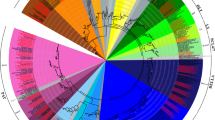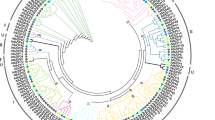Abstract
Serine/arginine-rich (SR) gene family members can diversify the transcriptome and proteome of eukaryotes by facilitating the alternative splicing (AS) of precursor messenger RNAs. Herein, we investigated the evolutionary dynamics, AS patterns, and expression levels of the Brassica rapa SR (BrSR) gene family in young seedlings treated with abiotic stresses. A comparative genomic analysis identified 25 BrSR genes at 18 Arabidopsis loci and three BrSR-like genes at two Arabidopsis loci. Thirteen of these loci were singletons, while seven loci carried paralogs. All the duplicated pairs were determined to be under purifying selection pressure. The expansion of the BrSR gene family was found to be the result of segmental duplications only. Additionally, the expression levels of 78.6% (22 of 28) and the AS patterns of 60.7% (17 of 28) of the BrSR genes were altered in response to abiotic stresses. Among the analyzed abiotic stresses, oxidative, cold, and heat treatments induced the largest expression changes, while cold and heat stresses caused most AS events. Our findings provide insights into the evolutionary dynamics of BrSR genes following polyploidization events, and provide an important resource for future studies aimed at characterizing the specific function(s) of BrSR genes in plant growth, development, and defense.
Similar content being viewed by others
References
Barker MS, Baute GJ, Liu SL (2012) Duplications and turnover in plant genomes. In Wandel F, Greilhuber J, Dolezel J, Leitch IJ, eds, Plant genome diversity, Ed 1, Springer, Vienna, pp. 155–69
Barta A, Kalyna M, Reddy AS (2010) Implementing a rational and consistent nomenclature for serine/arginine-rich protein splicing factors (SR proteins) in plants. Plant Cell 22:2926–2929
Bowers JE, Chapman BA, Rong J, Paterson AH (2003) Unraveling angiosperm genome evolution by phylogenetic analysis of chromosomal duplication events. Nature 422:433–438
Cheng F, Liu S, Wu J, Fang L, Sun S, Liu B, Li P, Hua W, Wang X (2011) BRAD, the genetics and genomics database for Brassica plants. BMC Plant Biol 11:136
Cheng F, Wu J, Fang L, Wang X (2012a) Syntenic gene analysis between Brassica rapa and other Brassicaceae species. Front Plant Sci 3:198
Cheng F, Wu J, Fang L, Sun S, Liu B, Lin K, Bonnema G, Wang X (2012b) Biased gene fractionation and dominant gene expression among the subgenomes of Brassica rapa. PLOS ONE 7:e36442
Cheng F, Mandáková T, Wu J, Xie Q, Lysak MA, Wang X (2013) Deciphering the diploid ancestral genome of the mesohexaploid Brassica rapa. Plant Cell 25:1541–1554
Cheng F, Wu J, Wang X (2014) Genome triplication drove the diversification of Brassica plants. Hortic Res 1:14024
Darracq A, Adams KL (2013) Features of evolutionarily conserved alternative splicing events between Brassica and Arabidopsis. New Phytol 199:252–263
Ding F, Cui P, Wang Z, Zhang S, Ali S, Xiong L (2014) Genomewide analysis of alternative splicing of pre-mRNA under salt stress in Arabidopsis. BMC Genomics 15:431
Drechsel G, Kahles A, Kesarwani AK, Stauffer E, Behr J, Drewe P, Rätsch G, Wachter A (2013) Nonsense-mediated decay of alternative precursor mRNA splicing variants is a major determinant of the Arabidopsis steady state transcriptome. Plant Cell 25:3726–3742
Duque P (2011) A role for SR proteins in plant stress responses. Plant Signal Behav 6:49–54
Gasteiger E, Hoogland C, Gattiker A, Duvaud S, Wilkins MR, Appel RD, Bairoch A (2005) Protein Identification and Analysis Tools on the ExPASy Server. In Walker JM, eds, The Proteomics Protocols Handbook. Humana Press, Totowa, pp. 571–607
Goodstein DM, Shu S, Howson R, Neupane R, Hayes RD, Fazo J, Mitros T, Dirks W, Hellsten U, Putnam N, Rokhsar DS (2012) Phytozome: a comparative platform for green plant genomics. Nucleic Acids Res 40:D1178–D1186
Graveley BR, Hertel KJ, Maniatis T (1999) SR proteins are “locators” of the RNA splicing machinery. Curr Biol 9:R6–R7
Graveley BR (2000) Sorting out the complexity of SR protein functions. RNA 6: 1197–1211
Iida K, Go M (2006) Survey of conserved alternative splicing events of mRNAs encoding SR proteins in land plants. Mol Biol Evol 23:1085–1094
Isshiki M, Tsumoto A, Shimamoto K (2006) The serine/arginine-rich protein family in rice plays important roles in constitutive and alternative splicing of pre-mRNA. Plant Cell 18:146–158
Kalyna M, Barta A (2004) A plethora of plant serine/arginine-rich proteins: redundancy or evolution of novel gene functions? Biochem Soc Trans 32:561–564
Koch MA, Haubold B, Mitchell-Olds T (2000) Comparative evolutionary analysis of chalcone synthase and alcohol dehydrogenase loci in Arabidopsis, Arabis, and related genera (Brassicaceae). Mol Biol Evol 17:1483–1498
Lareau LF, Brooks AN, Soergel DA, Meng Q, Brenner SE (2007) The coupling of alternative splicing and nonsense-mediated mRNA decay. Adv Exp Med Biol 623:190–211
Letunic I, Doerks T, Bork P (2015) SMART: recent updates, new developments and status in. Nucleic Acids Res 43:D257–D260
Librado P, Rozas J (2009) DnaSP v5: a software for comprehensive analysis of DNA polymorphism data. Bioinformatics. 25:1451–1452
Long JC, Caceres JF (2009) The SR protein family of splicing factors: master regulators of gene expression. Biochem J 417:15–27
Masterson J (1994) Stomatal size in fossil plants: evidence for polyploidy in majority of angiosperms. Science 264:421–424
Meyer K, Koester T, Staiger D (2015) Pre-mRNA splicing in plants: in vivo functions of RNA binding proteins implicated in the splicing process. Biomolecules 5:1717–1740
Moore MJ, Query CC, Sharp PA (1993) Splicing of precursors to mRNAs by the spliceosomes. In Gesteland RF, Cech RT, Atkins C, eds Raymond FG, Thomas RC, John FA, eds, The RNA world. Ed 2, Cold Spring Harbor Laboratory Press, NY, pp. 303–57
Mueller WF, Hertel KJ (2012) The role of SR and SR-related proteins in pre-mRNA splicing. In Lorkovic ZJ, eds, RNA binding proteins, Landes Bioscience, Austin, pp. 27–46
Palusa SG, Ali GS, Reddy AS (2007) Alternative splicing of premRNAs of Arabidopsis serine/arginine-rich proteins: regulation by hormones and stresses. The Plant J 49:1091–1107
Reddy AS (2004) Plant serine/arginine-rich proteins and their role in pre-mRNA splicing. Trends Plant Sci 9:541–547
Reddy AS (2007) Alternative splicing of pre-messenger RNAs in plants in the genomic era. Annu Rev Plant Biol 58:267–294
Richardson DN, Rogers MF, Labadorf A, Ben-Hur A, Guo H, Paterson AH, Reddy AS (2011) Comparative analysis of serine/argininerich proteins across 27 eukaryotes: insights into sub-family classification and extent of alternative splicing. PLOS ONE 6:e24542
Semon M, Wolfe KH (2007) Consequences of genome duplication. Curr Opin Genet Dev 17:505–512
Shepard PJ, Hertel KJ (2009) The SR protein family. Genome Biol 10:242
Simpson CG, Manthri S, Raczynska KD, Kalyna M, Lewandowska D, Kusenda B, Maronova M, Szweykowska-Kulinska Z, Jarmolowski A, Barta A, Brown JW (2010) Regulation of plant gene expression by alternative splicing. Biochem Soc Trans 38:667–671
Soltis DE, Albert VA, Leebens-Mack J, Bell CD, Paterson AH, Zheng C, Sankoff D, DePamphilis CW, Wall PK, Soltis PS (2009) Polyploidy and angiosperm diversification. Am J Bot 96:336–348
Tamura K, Stecher G, Peterson D, Filipski A, Kumar S (2013) MEGA6: molecular evolutionary genetics analysis version 6.0. Mol Biol Evol 30:2725–2729
Van de Peer Y, Fawcett JA, Proost S, Sterck L, Vandepoele K (2009) The flowering world: a tale of duplications. Trends Plant Sci 14:680–688
Voorrips RE (2002) MapChart: software for the graphical presentation of linkage maps and QTLs. J Hered 93:77–78
Wang X, Wang H, Wang J, Sun R, Wu J, Liu S, Bai Y, Mun JH, Bancroft I, Cheng F, et al. (2011) The genome of the mesopolyploid crop species Brassica rapa. Nat Genet 43:1035–1039
Woodhouse MR, Cheng F, Pires JC, Lisch D, Freeling M, Wang X (2014) Origin, inheritance, and gene regulatory consequences of genome dominance in polyploids. Proc Natl Acad Sci USA 111:5283–5288
Zhang C, Yang H, Yang H (2016) Evolutionary character of alternative splicing in plants. Bioinform Biol Insights 9:47–52
Author information
Authors and Affiliations
Corresponding author
Electronic supplementary material
Rights and permissions
About this article
Cite this article
Yoon, E.K., Krishnamurthy, P., Kim, J.A. et al. Genome-wide Characterization of Brassica rapa Genes Encoding Serine/arginine-rich Proteins: Expression and Alternative Splicing Events by Abiotic Stresses. J. Plant Biol. 61, 198–209 (2018). https://doi.org/10.1007/s12374-017-0391-6
Received:
Accepted:
Published:
Issue Date:
DOI: https://doi.org/10.1007/s12374-017-0391-6




